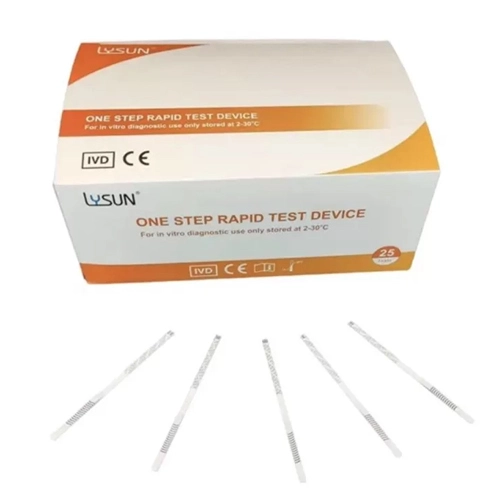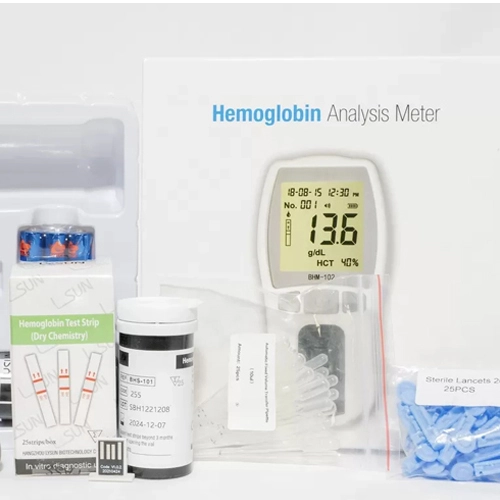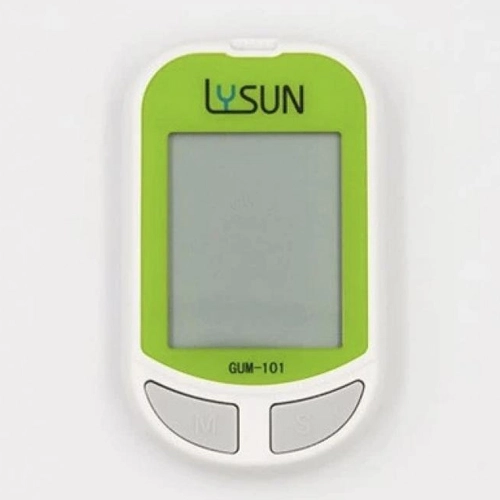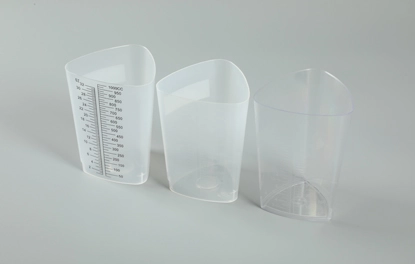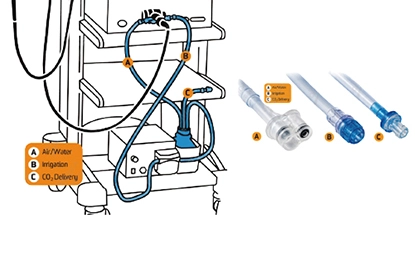- Medical Plastic Products
-
IVD Device
-
Blood Glucose Tester
- Smart Blood Glucose Measurement Tester HZ Blood Glucose Meter Home BHM-102
- Mircotouch Blood Sugar Glucose Meter Glucometer Monitoring System BGM-102
- HZ CE Approved Household Usage Quick Test Sugar Test Kit
- Customization Acceptable Handheld Electronic Home Use Blood Glucose Meter BGM-101/101N
- Code Free Diabetes Test Meter Glucose Monitor BGM-102
- Portable Blood Sugar Test Meter BGM-102
- HZ GULP-101 Triglycerides And Heart Rate Checker Blood Glucose Tester For Home Use
- Handheld Customizable Electronic Home Use Glucometer Blood Glucose Meter BGM-102
- Customize Blood Glucose Meter Blood Sugar Glucometer Monitor Diabetes Horse Dog Cat BGM-102
- High Precision Blood Glucose Meter Diabetes Monitor BGM-102
- Simple Operation Smart Glucose Monitor Diabetes Detecting
- HZ Diabetes Digital Glucometro Blood Gluco Meter, Blood Sugar Monitor Kit Blood Glucose Testing Machine
- Mini Blood Glucometer 5-second Accurate Result Diabetes Glucose Monitor Home Blood Glucose Meter CE ISO Apprpved
- Direct Sale Blood Glucose Meter For Household BGM101/101N
- HZ EGS-101 Blood Sugar Test Strips For Intelligent Glucose Analysis Instrument
- HZ GUM-101 Blood Glucose/Uric Acid Tester
- ISO9001 Fresh Capillary Blood Glucose Testing With HZ GUM-101
- 200 Records High Accuracy Glucose Meter With Strips BGM101
- HZ BGM-102 Blood Sugar Test Meter LCD Display Glucometer Kit
- HZ Glucometer Blood Sugar Test Diabetes Check Machine 50g
- HZ Diabetes Test Kit Portable Glucose Monitoring Devices BGM-102
- Electrochemistry Method HZ Glucometer Test Strips Sugar Monitor For Diabetes
- BGM-101 Diabetic Test Strips Blood Glucose Monitor
- Microinvasive Portable Blood Glucose Monitor Medical Device BGM-101
- Fresh Capillary Portable Blood Glucose Meter Sugar Check Machine BGM-102
- Large LCD Diabetes Test Meter Portable Blood Glucose Meter
- HZ GUM-101 Uric Acid Test Strips Portable Blood Sugar Tester 50g
- RoHS HZ Blood Glucose Tester GUM-101 For Hassle-Free Testing
- Smart HZ GULP-101 Blood Glucose Tester Multi-Function Glucose Analyzer
- 365g Blood Glucose Tester HZ GULP-101 Cholesterol And HDL Analyzer
- HZ GUM-101 Smart Data Analysis Blood Glucose Tester Uses Electrochemistry Method
- HZ GUM-101 Blood Glucose Tester 7*52*18mm Uric Acid Test At Home
- Glu 50 Records HZ GUM-101 Blood Glucose Tester Strips 50g
- HZ GUM-101 3.0V CR2032 Blood Glucose Tester Strip Uric Acid Testing
- UA 50 Records Uric Acid Blood Glucose Tester With HZ GUM-101
-
Hemoglobin Tester
- Reflectance Photometer Hemoglobin Tester HCT Testing With HZ BHM-101
- HZ BHM-101 Hemoglobin Tester Clinical Use Hematocrit Analyzer
- RoHS Reflectance Photometer Hemoglobin Tester With HZ BHM-101 Machine
- 1200mAh Hemoglobin Tester HCT Analyzer With User-Friendly Interface BHM-101
- High Precision BHM-101 Hemoglobin Tester HCT Analyzer Test For Medical Use
- CE Hemoglobin Tester Hemoglobin And Hematocrit Machine 800 Records
- BHM-101 HCT Analyzer Hemoglobin Tester For Accurate Blood Analysis Test
- 800 Records Hemoglobin Tester Hemoglobin HCT With HZ BHM-101 Analyzer
- Fast And Accurate 90% RH Hemoglobin Tester HCT Analysis With BHM-101 By HZ
- HZ Blood Hemoglobin HCT Analysis Meter For Home / Hospital Use BHM-102
- 800 Records Glycosylated Hemoglobin Test Hba1c Test Fasting With HZ BHM-102
- BHM-102 Hemoglobin HCT Analyzer Accurate Blood Glucose Meter
- Precise Hemoglobin HCT Measurement With HZ BHM-102 Hematology Analyzer
- User-Friendly Hemoglobin HCT Test Analyzer With BHM-102 By HZ
- ISO9001 Hba1c Diabetes Hemoglobin Blood Test With HZ BHM-102
- Hgb Blood Test Hemoglobin HCT Analyzer By HZ BHM-102 Test
- 1200mAh Microtouch Home Hemoglobin Analysis Digital Meter BHM-101
- Digital Portable Noninvasive Blood Hemoglobin Meter HZ BHM-102
- 800 Records Home Hemoglobin Test Meter Machine Portable BHM-102
- Precise Hemoglobin Tester HCT Measurement With BHM-101 Analyzer
- Electronic Digital HB Meter Hemoglobin Analyzer
- Hemoglobin Analyzer HB Test Meter
- Hospital Or Family Use Portable Hemoglobin Meter
- Rapid Self Test Blood Hemoglobin Analyzer Meter BHM-101
- Fully Automatic Hemoglobin Meter Analyzer
- Portable Handheld Hemoglobin Analysis Meter
- Hemoglobin Test Paper
-
Uric Acid Tester
- Uric Acid Testing Kits Home Uric Acid Blood Level Tester Machine GUM-101
- GUM-101 Home Blood Uric Acid Self Test Kit
- Rapid Diabetes Test Uric Acid Testing Kit With GUM-101
- GUM-101 Rapid Blood Glucose Test 50g Glu 50records UA 50 Records
- 1min Automatic Shut Off GUM-101 Cholesterol Glucose Uric Acid Test 50g
- Intelligent Recognition GUM-101 Automatically Uric Acid Meter Test Kit
- Heart Rate Blood Pressure Monitor Uric Acid Test Meter GULP-101
- GULP-101 Multi-Parameter Analyzer Uric Acid Test Machine 365g
- GULP-101 HDL Glucose Cholesterol Uric Acid Meter For Diabetes Management Uric Acid Test
- Compact And Lightweight GUM-101 Portable Uric Acid Test Meter
- RFM-101 Rechargeable Uric Acid Tester With Bluetooth Connectivity
- Home Uric Acid Tester With RFM-101 Reflectance Photometer
- Monitoring Uric Acid Levels Uric Acid Tester With RFM-101 Portable Meter
- 500 Records Gout Test Kit Uric Acid Tester With RFM-101 Reflectance Photometer
- CE Uric Acid Tester Bluetooth Enabled Blood Glucose Meter 90g
- Streamline Uric Acid Tester Bluetooth Enabled Glucose Meter RFM-101
- RoHS Uric Acid Tester With RFM-101 Reflectance Photometer And Mobile App
- 1200mAh Uric Acid Tester With RFM-101 Rapid Test Meter
- RFM-101 Reflectance Photometer Uric Acid Tester Solution
- 500 Records Uric Acid Tester With RFM-101 Portable Reflectance Photometer
- Easy Touch Uric Acid Test Kit
- Uasure Uric Acid Test Strips
- Blood Glucose Uric Acid Meter Multi-function Glucometer Uric Acid Meter
- Kidney Function Test Strips
- Home Use Multifunction Monitoring System Glucose Uric Acid Analyzer
- 2 in 1 Machine High Precision Uric Acid Blood Glucose Analyzer
- 2 in 1 Blood Glucose & Uric Acid Meter Tiny Specimen Health Care
- High-precision Uric Acid Meter
- Glucose Uric Acid Analysis Meter
- Blood Glucose Meter Uric Acid Monitor With Test Strip
- Intelligent Model Multifunctional Analysis Meter Glucose Uric Acid
- Auto Recognize Strips Uric Acid Test Strip
- Diabetes Uric Acid Tester
- Electrochemistry Method 2 in 1 Glucose& UA Multifunction Analysis Meter
- Digital Sugar Uric Acid Test Strip Active Blood Glucose Meter
-
Blood Lipid Analyzer
- Blood Lipid Analyzer PFS-30 (With Bluetooth) PFS-30A
- 4 in 1 Panel Quick Blood Lipid Analyzer For TC, TG, HDL, LDL
- LPM-102 Lipid Profile Panel Blood Test For TC / HDL / TG / LDL Analysis
- Lipid Profile Test Kit Analyzer LPM-102 For Cardiovascular Risk Assessment
- 500 Records Blood Lipid Analysis Meter Portable Lipid Analyzer 90g
- LPM-102 Lipid Profile Machine For LDL Analysis With Intelligent Printer Linkage
- LPM-102 Lipid Profile Test Machine For Comprehensive Lipid Analysis
- LPM-102 Lipids Blood Test Machine With TC/HDL Ratio Calculation
- LPM-102 Lipid Profile Test 500 Records Portable Lipid Test System
- LPM-102 Lipid Test Device Health Monitoring Triglycerides Tester
- Multiple Functions 500 Records Lipid Meter LPM-102
- LPM-102 Blood Lipid Test Meter 500 Records
- DBM-101 Renal Function Test Lipid Tester 3 In 1 Cholesterol Meter
- DBM-101 Fast Blood Lipid Tester With Bluetooth Connectivity
- DBM-101 Rechargeable Blood Lipid Tester With Long Battery Life
- DBM-101 Digital Blood Lipid Tester With Large Memory And Auto Shut-Off
- Portable DBM-101 Comprehensive Blood Lipid Tester Easy-To-Read Display
- Comprehensive Blood Lipid Tester DBM-101 With HDL TG And TC Analysis
- Health Monitoring DBM-101 Lipid Tester Renal Function Testing
- DBM-101 TC HDL TG Measurements Lipid Tester 500 Records
- DBM-101 Portable Blood Lipid Tester Renal Function Test Solution
- DBM-101 Lipid Tester Renal Function Testing With Bluetooth Syncing
- Triglycerides Test Strip
- Triple-in-one Lipid Monitor HDL LDL Triglycerides Cholesterol
- Multi Parameters Dry Biochemistry Analyzer For Blood Lipid, Renal Function
- Handheld Cholesterol Blood Lipid Meter Monitoring
- 3 In 1 Blood Lipid Test Strip Total Cholesterol, Triglycerides, High Density Lipo-protein TC/TG/HDL/LDL For POCT Analyzer
- IVD Reagent Lipid Profile Dry Chemistry Test Strips By Meter Portable Lipid Profile Analyzer
- Dry Chemistry Analyzer Blood Lipid Renal Function Analysis Meter
- Medical Home Used Portable Blood Lipid Meter
- Total Cholesterol HDL Triglycerides LDL Blood Lipid Analyzer Meter For Hospital Diagnostic Agency
- Medical Equipment Total Cholesterol Creatinine Meter Dry Biochemical Analyzer Renal Function Analysis Meter
- CE 6 in 1 TC/TG/HDL/UR/UA/CR Dry Biochemical Analysis Meter For Cholesterol
- Household Medical Cholesterol Meter
-
Renal Function Tester
- 5 Mins Blood Test Machine Renal Kidney Profile Test RFM-101
- Dry Biochemical Analysis Creatinine Test Strip Renal Function Analysis Meter
- DBM-101 Portable Blood Lipid And Renal Function Panel Test 90g
- DBM-101 Kidney Disease Blood Test Bluetooth Enabled
- DBM-101 Multi-Functional Blood Lipid And Renal Function Blood Test
- DBM-101 Kidney Blood Test Blood Lipid Analyzer 500 Records
- DBM-101 Blood Lipid Analysis Meter Test For Kidney Function
- DBM-101 Blood Lipid Renal Function Analysis Meter 500 Records
- Kidney Function Test Dry Biochemical Analysis Meter DBM-101
- RFM-101 Rechargeable Uric Acid Test Meter With Bluetooth Connectivity
- Renal Function Testing With DBM-101 UA CR And UR Analysis
- DBM-101 Precise Blood Lipid And Renal Function Test Meter For Home Use
- RFM-101 Renal Function Test With Rapid Results And Bluetooth Connectivity
- 300 Second Rapid Testing Renal Function Test FM-101 Automatically Update
- Kidney Health RFM-101 Bluetooth-Enabled Renal Function Test 90g
- RFM-101 Rechargeable Renal Function Test Results In 300 Seconds
- Renal Function Testing With RFM-101 Bluetooth Syncing And Mobile App Management
- 500 Records Renal Function Testing With RFM-101 Whole Blood Plasma And Serum Specimen Capability
- RFM-101 Kidney Health Monitoring Renal Function Test With 1200mAh Li-Ion Battery
- RFM-101 Renal Function Test 500 Records With User-Friendly Mobile App
- 3 in 1 Renal Function Test Strip
- Urea Analysis Meter
- Renal Function Analysis Meter
- Kidney Function Test Strip
- Clinical Analytical Renal Function Analyzer Creatinine Test
- Economic Renal Function Analysis Meter
- Long Endurance Renal Function Meter
- Safe-accu Renal Function Test Machine For Creatinine, Uric Acid, Urea
- Economic Home Renal Function Analysis Digital Meter
- New Design Renal Function Analyzer For Uric Acid(UA)/Creatinine(CR)/Urea(UR) Clinic Home Use
- Health Care Digital Renal Function Analysis Digital Meter And Strips
- Automatic Chemistry Analyzer Portable CE Biochemistry Analyzer For Liver Renal Function Test
- Handheld Renal Function Analyais Meter
- Renal Function UR CR UA Test Meter
- Renal Function Analysis Meter And Strips
- Dry Biochemical Analysis Creatinine Meter Medical Health Care Blood Lipid Renal Function Analysis Meter
-
Antigen Test Infectious
- Rapid and Accurate HCV Antibody Testing with HCVAb Cassette Test HCV-W11
- MP Biomedicals Rapid Antigen Test For Pneumonia Diagnosis MP-P21-GM
- Flu A+B Test With Strip Format Antigen Test Infectious FLU-S11
- Diagnosis Of Syphilis With SYP Rapid Test Cassette SYP-W21
- Malaria Test Diagnosis With MAL-W21-FA Rapid Test Cassette
- Torch Rapid Test Kit Simultaneous Detection Of Rubella CMV HSV And TOXO Antibodies TOR-W24-GM
- Antigen Test Infectiousness Diagnosis With CHA Test For Chagas Disease CHA-101
- TOXO IgM Test For Early Detection Of Toxoplasmosis TOX-W21-M
- FLUA+B COVID-19 RSV Rapid Test For Respiratory Infections
- HBcAb Test Cassette For Hepatitis B Virus Detection HBcAb-W21
- Hepatitis B E Antigen Detection With HBcAg Test Cassette HBcAg-W21
- Swab Strep A Testing Strip Antigen Test Infectious STP-S11
- HP-P21 Antigen Test Infectious H Pylori Antigen Rapid Test Cassette
- Helicobacter Pylori Test Antigen Test Infectious HP-W11
- Strep A Rapid Test Cassette Antigen Test Infectious STP-S21
- Syphilis Detection With SYP Test Strip Antigen Test Infectious SYP-P11
- Syphilis Pregnancy Test Strip Antigen Test Infectious SYP-W11
- Rapid And Accurate Malaria Testing With MAL-W21-FV Cassette Antigen Test Infectious
- HIV HBsAg Rapid Antigen Test Infectious BIV-W22 Cassette
- EV71 IgM Rapid Test Antigen Test Infectious EV-W11 Cassette
- Fast and Accurate Chikungunya Virus Detection with CHI Rapid Test
- Rapidly Detect HSV IgG/IgM with Our HSV Test Cassette HSV-W21-GM
- Fast and Accurate HSV IgM Testing with the HSV Rapid Test HSV-W21-M
- Fast and Accurate Diagnosis of Rubella with Rubella IgG/IgM Rapid Test RUB-W21-GM
- Fast and Accurate Diagnosis with Rubella IgM Rapid Test Kit RUB-W21-M
- Fast and Accurate CMV IgG/IgM Testing with CMV Rapid Test CMV-W21-GM
- Fast and Accurate CMV IgM Rapid Test for the Detection of Cytomegalovirus Infections CMV-W21-M
- Quick and Accurate TOXO IgG/IgM Testing with Our Rapid Test Kit TOX-W21-GM
- Rapid Torch Test for Accurate Detection of Rubella, CMV, HSV, and TOXO IgM Antibodies TOR-W24-G
- Fast and Accurate Detection of Multiple Infections with HBsAg/HCV/HIV/Syphilis Combo Test BCIS-P24
- Fast and Accurate Diagnosis with HBsAg/HCV Rapid Test Cassette BCV-W22
- Rapid and Accurate Diagnosis of Malaria with MAL-W11-FA Strip Test
- Rapid and Accurate Detection of Malaria Pf/Pv with the Malaria Test Strip MAL-W11-FV
- Quick and Accurate Malaria Pf Detection with our Rapid Test Strip MAL-W11-F
- Fast and Accurate H. Pylori Testing with the HP-F21 Rapid Test Cassette
- Rapid H. Pylori Test Strip for Accurate Diagnosis Antigen Test Infectious HP-P11
- Rapid Test for Detection of Influenza A and B Antigen Test Infectious FLU-S21
- Rapid FLU B Test for Quick and Accurate Diagnosis Antigen Test Infectious IFU-S21
- Rapidly Detect HAV Infections with HAV Ag Test Cassette HAV-W31-AG
- Infectious Disease Rapid Test: MP IgM Test for Rapid and Accurate Diagnosis MP-P11
- Rapid HAV IgM Testing with HAV Test Cassette for Early Detection HAV-P11
- Rapid and Accurate Testing for Hepatitis B, Hepatitis C, HIV, and Syphilis with BCIS Test BCIS-W11
- Fast and Accurate Diagnosis of Cholera with CHO Test Cassette CHO-F21
- Fast and Accurate Diagnosis of Cholera with CHO Test Cassette Antigen Test Infectious CHO-F11
- Rapid and Accurate Rotavirus Testing with ROTA, ADENO Test Cassette ROT-F21
- Rapid and Accurate Typhoid/Para Typhoid Ag Detection with TPPA-F22 Test
- Fast and Accurate Typhoid Ag Test for Fecal Specimens Antigen Test Infectious TYP-F21
- Rapid and Accurate Typhoid Test with Typhoid IgG/IgM Cassette TYP-W21
- Fast and Accurate Typhoid Test for Early Diagnosis Antigen Test Infectious TYP-P21
- Fast and Accurate HCV Antibody Testing with HCVAb Cassette Test Antigen Test Infectious HCV-W21
-
Drug Of Abuse Test
- Quick and Accurate Detection of PPX in Urine Using Rapid Diagnostic Cassette PPX-U102
- Accurately Detect EDDP in Urine with Our Rapid Diagnostic Drug Test EDDP-U102
- Rapid Diagnostic Drug Test Cassette For MET Detection In Urine MET-U102
- 200ng/ML Detection Of TRA Rapid Diagnostic Test Cassette TRA-U102
- 30ng/ML 50ng/ML K2 Urine Drug Test Diagnostic Drug Test Cassette
- Fast Detection Of Cotinine COT Medical Drug Urine Test 200ng/ML
- Urine ETG-U103 Drug Of Abuse Test ETG Test Kit Panel
- Rapid Diagnostic Drug Test Strip For MET Detection In Urine Drug Of Abuse Test MET-U101
- Rapid Detection TRA Drug Test Drug Of Abuse Test 200ng/ML
- 100ng/ML TML Urine Drug Test Strip Drug Of Abuse Test TML-U101
- Rapid Diagnostic For Saliva Samples Drug Of Abuse Test ACO-U101
- ETG Testing For Alcohol Consumption Drug Of Abuse Test ETG-U101
- Drug Of Abuse Test ETG Test Cassette For Alcohol Detection In Urine ETG-U102
-
Fertility Tester
- Pregnancy Detection Fetal Fibronectin Test HCG Fertility Test 25mIU/Ml
- Healthcare Serum Urine HCG Pregnancy Test Cassette 25mIU/Ml
- CE HCG Midstream Fertility Test One Step HCG Urine Test 25mIU/ml
- 25mIU/Ml HCG Pregnancy Test Strip Kit In Urine For Serum
- Rapid HCG Test Cassette For Serum Detect Pregnancy Early And Accurately HCG-P21
- 25mIU/ml HCG Test For Fertility Monitoring HCG-M21 Fertility Test
- LH Test Strip For Accurate Ovulation Prediction Fertility Test LH-U11
- 25mIU/Ml LH Ovulation Rapid Test Cassette Detect Luteinizing Hormone
- 25mIU/Ml Fertility Monitoring LH Test Strip Fertility Tester LH-U31
- FSH Urine Test Cassette For Fertility Evaluation Fertility Tester FSH-U21
- 25mIU/Ml Midstream FSH Urine Test Fertility Tester Detects FSH Levels
- IGFBP-1 Urine Test For Fertility Assessment FBP-U11 Fertility Tester 50pcs
- Rapid FFN Test Strip Fertility Tester 25ng/Ml Diagnose The Risk Of Preterm Labor
- Fertility Tester With FFN Urine Test Cassette FFN-U21
-
Cardiac Marker Test
- High Sensitivity Cardiac Risks CRP Test For Early Detection Cardiac Marker Test CRP-101
- Cardiac Diseases Early Detection CTI Test Cardiac Marker Test 0.3ng/Ml 0.5ng/Ml
- Detect Cardiac Ischemia CTI Test Cassette Cardiac Marker Test CTI-P21
- 5ng/Ml CKMB Test For Rapid Cardiac Marker Test Detection Cassette CKMB-W21
- Myoglobin Detection MYO Test MYO-W21 Cardiac Marker Test 50ng/Ml
- PCT Testing With PCT Test Strip PCT-W11-1 Cardiac Marker Test 0.5ng/Ml
- PCT-W21-1 PCT Test Cassette Cardiac Marker Test 0.5-10 Ng/ML
- Reliable and Fast Results with the SAA Test Strip and Cassette SAA-W21
- Rapid SAA Test for Early Detection of Systemic Inflammation SAA-W11
- High-Sensitivity CRP Test Cassette for Efficient Detection of Cardiovascular Diseases CRP-W21-2
- Detect Inflammation and Monitor Disease Progression with CRP Test Strip CRP-W21-1
- Accurately Detect Procalcitonin Levels with the PCT Test Cassette PCT-W21-2
- High Sensitivity PCT Test Strip for Rapid Detection of Infection PCT-W11-2
- Rapid CRP Test for Quick and Accurate Diagnosis of Inflammatory Conditions CRP-102
- Covid-19/FluAB Test Kit
- Health Watch
-
Blood Glucose Tester
- Sleep Aid Device
- Medical Recovery Products
- Medical Beauty Equipment
In Vitro Diagnostics (IVD) Market Size, Share and Industry Analysis 2024 to 2032
The global in vitro diagnostics (IVD) market size was valued at USD 74.92 billion in 2023 and is expected to grow from USD 73.99 billion in 2024 to USD 117.6 billion in 2032, registering a CAGR of 6.0% during the forecast period (2024-2032). North America dominated the global market in 2023 with a share of 37.21%.
In vitro diagnostics (IVD) are medical devices that perform diagnostic tests on biological samples such as blood, urine, and tissue. These tests help detect and monitor infectious diseases, autoimmune diseases, and a variety of diseases, and are also used to analyze adjustments to medication therapy from time to time. Furthermore, these tests influence approximately 70% of clinical decisions, according to the British Society for In Vitro Diagnostics.
Market trends:
The popularity of point-of-care testing equipment continues to increase
The rising incidence of acute and chronic diseases has prompted medical device companies to introduce technologically advanced diagnostic equipment. As the disease burden continues to increase, medical device companies are vigorously developing technologically advanced diagnostic equipment. Hospitals and laboratories have also shown a growing preference for point-of-care testing devices to obtain accurate, real-time data. Point-of-care (PoC) testing is performed near the patient, typically requires only a small amount of blood, and provides faster test results during the clinical decision-making process, allowing physicians to make early treatment decisions without waiting for results from a central laboratory. This factor is likely to increase the demand for point-of-care testing devices, ultimately driving the demand for in vitro diagnostic devices.
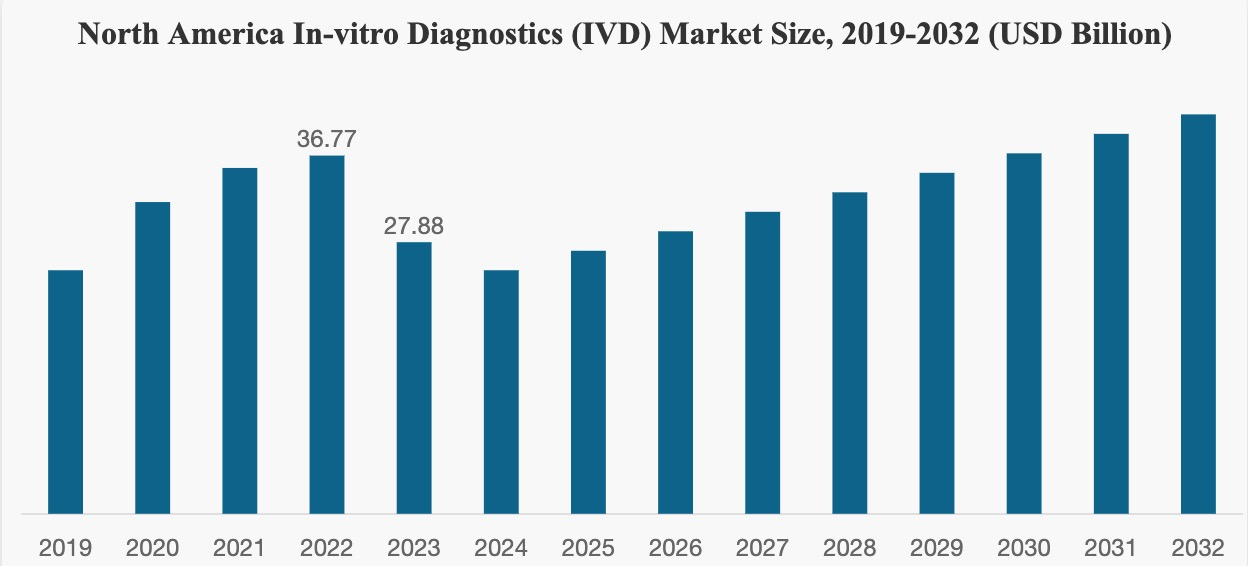
Growth factors:
The growing burden of chronic diseases and the need for in vitro diagnostic testing in large numbers of patients
The rising incidence of multiple diseases, including genetic, cardiovascular, and neurological diseases, places a heavy burden on health care. Effective use of IVDs in early diagnosis of these diseases allows physicians to effectively administer appropriate treatment.
For example, non-communicable diseases (NCDs) are responsible for 41 million deaths, equivalent to 74% of all deaths globally, according to a September 2022 fact sheet from the World Health Organization.
This growing disease burden can be easily controlled as long as both patients and physicians are aware of the importance of early diagnosis and use in vitro diagnostic devices effectively. In addition, the increase in the geriatric population has also increased the susceptibility to diseases such as hypertension, liver and kidney diseases, cardiovascular diseases, etc., which is likely to support the growth of the market
Increasing funding and government support for development and use of IVD devices promotes market growth
Government organizations, associations, and institutions drive market growth by launching awareness campaigns to encourage the use of in vitro diagnostic products. To prioritize diseases based on burden and prevalence, WHO has published a model list of essential in vitro diagnostic products for primary health care and health care facilities with clinical laboratories. These two categories are further subdivided into general in vitro diagnostic products and specific diseases.
Additionally, increasing research and government funding are supporting the development of innovative products, further driving market growth.
IVD market segmentation analysis
With the emergence of advanced products, reagents and consumables will be widely adopted
On the basis of product type, the market is segmented into instruments and reagents and consumables. The reagents and consumables segment accounted for the dominant share of the in vitro diagnostics market in 2023 owing to surge in usage of self-test kits, POC tests, and several other advanced in vitro diagnostics products. The increasing number of R&D activities for diagnosing chronic diseases is one of the major factors driving the demand for reagents and consumables. Furthermore, the increasing emphasis on early diagnosis in both developed and emerging countries has increased the number of patients undergoing routine check-ups, thereby contributing to strong growth in this field.
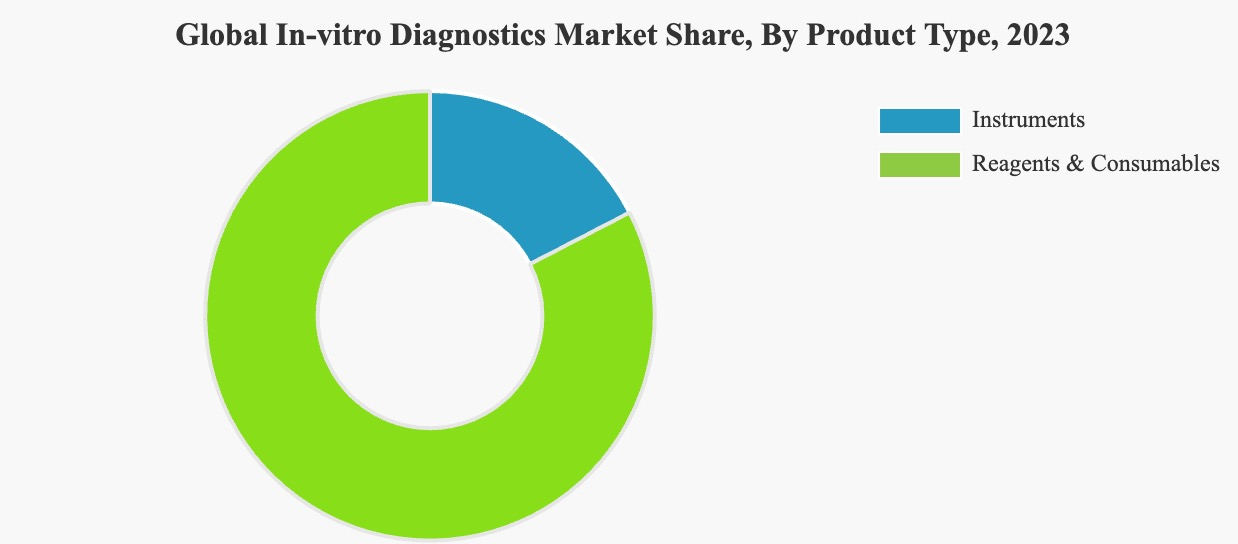
Analysis by technical
Technological advances in molecular diagnostic equipment drive demand
On the basis of technology, the market is segmented into immunodiagnostics, clinical chemistry, molecular diagnostics, hematology, and others.
The field of molecular diagnostics dominated 2023 due to the increasing demand for molecular diagnostics in infectious diseases. As the COVID-19 pandemic sweeps the world, the SARS-CoV-2 virus that causes this infection is diagnosed using quantitative real-time reverse transcription PCR (qRT-PCR). Increasing R&D activities by market players are leading to the launch of innovative instruments based on new technologies in the market.
Analyze by settings
Popularization of home diagnostics will drive growth of point-of-care diagnostics market
On the basis of environment, the market is segmented into laboratory and point-of-care diagnostics. The lab segment dominates in 2023. This is due to the increasing adoption of advanced instrumentation in this setting by developing countries, as well as rapid public and private sector investment in laboratory infrastructure. Additionally, most complex and sensitive diagnostic tests are performed in laboratories, requiring skilled laboratory staff, specialized equipment, and more run time.
In vitro diagnostic devices are widely used in the treatment of infectious diseases
In terms of application, the market is segmented into infectious diseases, cardiology, oncology, gastroenterology, and others. The infectious diseases segment accounted for the largest share in 2023 owing to rising prevalence of these diseases globally.
For example, tuberculosis remains one of the world's deadliest infectious diseases, second only to COVID-19, according to the European Center for Disease Prevention and Control, and drug-resistant TB strains remain a major problem.
Additionally, rising geriatric population increasing susceptibility to infectious diseases including hepatitis, diphtheria, etc., along with increasing number of outbreaks, may support segment growth of this market.


